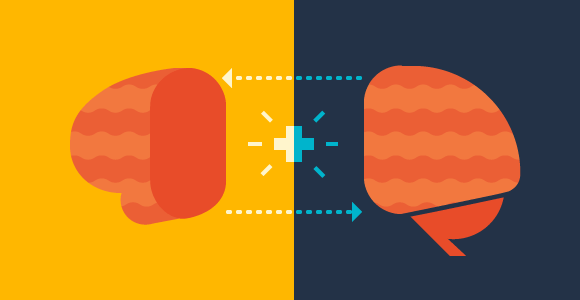About the Video
Let us assume that the US Senate is a microcosm of the American ideological landscape. For the past 30 years, Americans have, on average, been split down the middle in their conservative or liberal tendencies.1 This is no fluke. Mounting evidence suggests that our basic ideological proclivities are rooted in biology. Certain personality traits move roughly half of us to the right and half to the left. This, of course, is not an absolute. As a whole, our personal beliefs fall along a continuum, but when forced to choose sides, a clear and equal divide emerges.
The science behind our split ideologies is in its infancy. Psychologists and neuroscientists are beginning to piece together a complex tapestry of possible biological and psychological mechanisms for why this divide exists. The challenge, however, is that when looking at our brains, neuroplasticity can muddy the waters, calling into question the direction of causality. In other words, does our brain structure cause us to be conservative/liberal, or does our conservatism/liberalism cause our brain structure to change? Several longitudinal studies suggest the former, but more study is needed before a verdict is rendered.2
So, while it's obvious that an ideological divide exists, the question must be asked – why? If this isn't a fluke but rather a biological bi-product of evolution, how do we benefit from this contentious split? Perhaps it is a matter of yin and yang. These parallel ideologies, ironically, are complimentary forces that keep society running on an even keel.3 Of course, this is up for debate.
1 Composition of Congress, by Political Party, 1855-2015. Web 1 May 2013. Raw data. Infoplease.com, Pearson Education, Inc.
2 Jost, John T, and David M. Amodio. "Political Ideology As Motivated Social Cognition: Behavioral and Neuroscientific Evidence." Motivation and Emotion. 36.1 (2012): 55-64. Print.
3 Haidt, Jonathan. "The Moral Roots of Liberals and Conservatives." Lecture. TED. Monterey. Mar. 2008. TED.com. TED Conferences, LLC, Sept. 2008. Web. Apr. 2013.
Transcript
Is our political ideology simply the result of a genetic coin toss?
Dozens of behavioral studies have found that conservatives consistently test high on psychological measures of personal need for order, structure, and closure while also showing greater sensitivity to fear and disgust.1 In contrast, liberals test high on psychological measures for tolerance of ambiguity and complexity, and for openness to new experiences. As an aside, these assessments should not be taken as a criticism or an endorsement of one ideology over another. It’s important to understand these distinctions, for which there are reams of empirical evidence, because they provide a critical jumping off point for further study.
In 2005, researchers compared the shared attitudes of fraternal and identical twins toward 28 different political issues including unions, pornography, abortion, school prayer, and divorce.2 Heritability accounted for roughly 53% of variance. In other words, with statistical significance, identical twins were more likely than fraternal twins to agree on matters that would traditionally be considered hot-button issues in any ideological debate.
In 2006, researchers published the results of a 20-year study supporting the argument that genetics influence ideology.3 Personality traits identified in 3 year-olds were predictive of one’s conservative or liberal bent as an adult. Children defined by teachers as “fearful, rigid, indecisive, vulnerable, and inhibited tended to be more politically conservative as adults.”4 On the flip side, children described as “more energetic, resilient, self-reliant, expressive, dominating, and more prone to developing close relationships” tended toward liberalism as adults.
These first two studies established a correlate, but failed to identify a biological or psychological cause for these differences. In 2011, a study took a closer look at the brain structure of conservatives and liberals.5 Premised in part on prior studies wherein conservatives registered stronger reactions to fear, researchers used MRI scans to examine the amygdala – that part of the brain central to the physiological and behavioral responses to a threat. Low and behold, conservatives showed increased gray matter in the amygdala. And liberals? They showed increased gray matter in the anterior cingulate cortex – that area of the brain associated with conflict monitoring. These physical correlations were so strong that conservatives and liberals were identified with over 70% accuracy from their MRI scans alone. And like that, a biological mechanism was identified.
1 Amodio, DM, JT Jost, SL Master, and CM Yee. “Neurocognitive Correlates of Liberalism and Conservatism.” Nature Neuroscience. 10.10 (2007): 1246-7. Print.
2 Alford, John R, Carolyn L. Funk, and John R. Hibbing. “Are Political Orientations Genetically Transmitted?” American Political Science Review. 99.2 (2005). Print.
3 Block, J, and J.H Block. “Nursery School Personality and Political Orientation Two Decades Later.” Journal of Research in Personality. 40.5 (2006): 734-749. Print.
4 Jost, John T, and David M. Amodio. “Political Ideology As Motivated Social Cognition: Behavioral and Neuroscientific Evidence.” Motivation and Emotion. 36.1 (2012): 55-64. Print.
5 Kanai, R, T Feilden, C Firth, and G Rees. “Political Orientations Are Correlated with Brain Structure in Young Adults.” Current Biology : Cb. 21.8 (2011): 677-80. Print.
Share/Embed
Share Video
Embed
Explore Free Online College Courses from Our Featured Universities
-
Massachusetts Institute of Technology
 232 Courses
232 Courses -
Stanford University
 161 Courses
161 Courses -
University of California, Berkeley
 64 Courses
64 Courses
Most Popular Playlists
-

First Day of Freshman Year
Relive the first day of your freshman year with a series of first lectures from introductory college courses at MIT, Yale, and Stanford.
-

Laws of Nature
Introduce yourself to the laws of nature with these free online college lectures from Yale, Harvard, and MIT.
-

Living a Good Life
Gain fresh perspective on how to live a good life with these lectures taken from free college courses offered by Yale.
Related Degrees